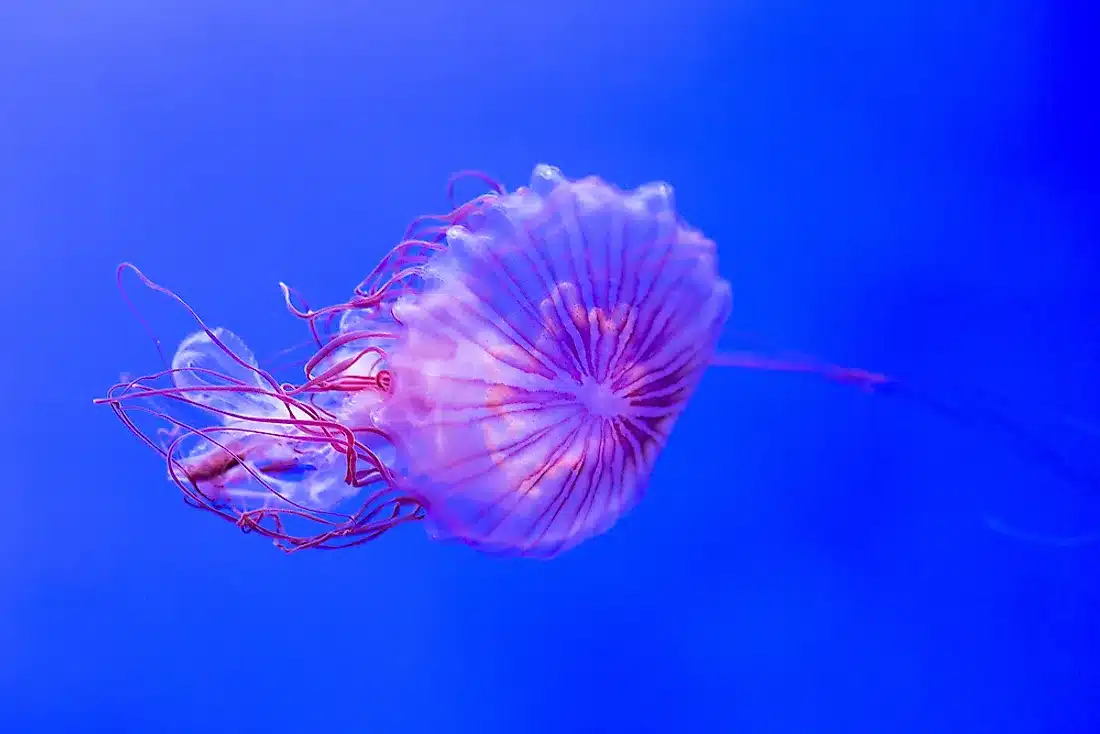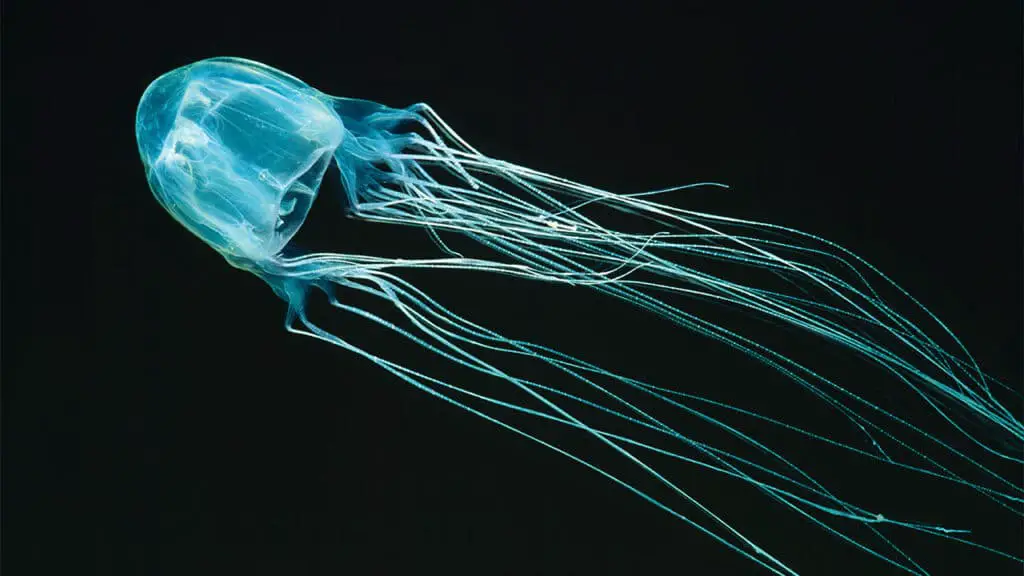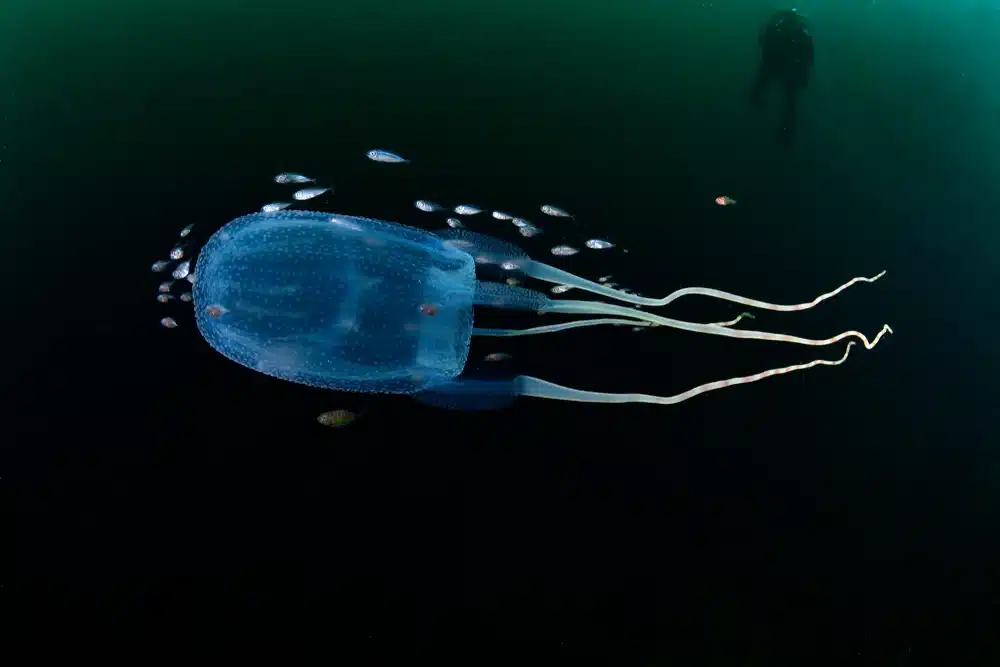What Is The Deadliest Jellyfish

Introduction
What Is The Deadliest Jellyfish: The mesmerizing world beneath the ocean’s surface is a realm of wonder and mystery, teeming with an astonishing diversity of life. Among its many inhabitants, jellyfish stand out as captivating yet enigmatic creatures. While jellyfish come in countless shapes, sizes, and colors, some species wield a deadly weapon that has earned them a fearsome reputation – their venomous stingers.
In this exploration, we delve into the depths of the ocean to uncover the secrets of the deadliest jellyfish. These gelatinous beings possess a potent arsenal, which, in the blink of an eye, can transform a serene swim into a harrowing encounter. As we embark on this journey, we will unravel the intricacies of these oceanic assassins, from their physical adaptations to their hunting strategies.
Our quest begins by shedding light on some of the most notorious culprits. From the infamous box jellyfish to the hauntingly beautiful but lethal Portuguese man o’ war, we will introduce you to these venomous assassins of the sea, examining jellyfish habitats and behaviors that make them such formidable predators.
Beyond the sheer danger they pose to unsuspecting swimmers, these jellyfish offer insights into the intricate web of life in the ocean, where survival often hinges on one’s ability to adapt and evolve. Join us as we navigate through the realms of science, nature, and peril, uncovering the captivating and deadly world of jellyfish.

What jellyfish kills the most humans?
Box Jellyfish
Box Jellyfish | National Geographic. The box jellyfish’s venom is among the most deadly in the world, containing toxins that attack the heart, nervous system, and skin cells.
The jellyfish that claims the dubious distinction of being the most lethal to humans is the box jellyfish, specifically Chironex fleckeri. This enigmatic and translucent predator inhabits the waters of the Indo-Pacific region, particularly around Australia’s northern coastline. While its elegant, bell-shaped appearance might seem innocuous, its tentacles hide an arsenal of microscopic darts filled with venom potent enough to kill a human in minutes.
The box jellyfish’s sting is excruciatingly painful, but what makes it particularly deadly is its ability to induce cardiac arrest and neuromuscular paralysis. A single encounter with this jellyfish can lead to drowning, as the victim’s ability to swim or stay afloat is compromised due to the paralysis.
Though fatalities are relatively rare, prompt medical attention is crucial to counter the effects of a box jellyfish sting. Vinegar is commonly used to neutralize the nematocysts (stinging cells), but the ultimate key to survival lies in antivenom and medical intervention.
Understanding the box jellyfish and its lethal potential serves as a stark reminder of the awe-inspiring yet perilous nature of marine life. It underscores the importance of respecting the oceans and their inhabitants, as well as the need for ongoing research to protect both humans and these captivating, albeit deadly, creatures of the deep.
What are the top five deadliest jellyfish?
Here is an additional list of the five most deadly jellyfish in the world.
- Sea Nettle. The sea nettle jellyfish are among the venomous jellyfish found on the Atlantic and Gulf coasts.
- Lion’s Mane Jellyfish.
- Cannonball Jellyfish.
- Irukandji jellyfish.
- Moon jellyfish.
The world’s oceans are home to a plethora of jellyfish species, and among them, several stand out as the top five deadliest due to their potent venom and the harm they can inflict on humans:
- Box Jellyfish (Chironex fleckeri): This jellyfish, found primarily in the waters of Australia’s northern coast, is often regarded as the most venomous marine creature in the world. Its tentacles are loaded with toxins that can lead to cardiac arrest and paralysis, potentially causing death within minutes.
- Irukandji Jellyfish: These small but exceedingly venomous jellyfish, found in Australian waters, are notorious for causing Irukandji syndrome. Symptoms include severe pain, vomiting, and even heart failure.
- Portuguese Man o’ War (Physalia physalis): Despite resembling a single organism, the Portuguese Man o’ War is actually a colony of specialized polyps working together. Its long, trailing tentacles can deliver excruciating stings, occasionally leading to severe allergic reactions.
- Sea Wasp (Chironex yamaguchii): Another species of box jellyfish, the sea wasp is found in the waters of Southeast Asia. Its venom is potent enough to be fatal, and prompt medical attention is essential for survival.
- Sea Nettle (Chrysaora quinquecirrha): These jellyfish are found in the Atlantic and Pacific oceans and possess long, stinging tentacles. While their stings are usually not fatal to humans, they can cause significant pain and discomfort.
Encounters with these deadliest jellyfish species highlight the importance of caution and respect when enjoying marine environments. Vigilance and knowledge of local species are crucial to minimizing the risks associated with these remarkable yet potentially perilous creatures of the sea.
What jellyfish hurts the worst?
Irukandji jellyfish have the ability to fire stingers from the tips of their tentacles and inject venom. Irukandji jellyfish’s stings are so severe they can cause fatal brain hemorrhages and on average send 50-100 people to the hospital annually.
Among the diverse array of jellyfish inhabiting the world’s oceans, the “Portuguese Man o’ War” (Physalia physalis) is often considered to deliver one of the most excruciating and painful stings. Despite its resemblance to a jellyfish, the Portuguese Man o’ War is not a single organism but a colonial creature composed of specialized polyps working together in a symbiotic relationship.
What makes its sting particularly notorious is the long, tentacle-like structures that trail beneath the surface, often extending up to 30 feet (9 meters). These tentacles are equipped with thousands of nematocysts, which are microscopic stinging cells filled with venom. When a person comes into contact with these tentacles, the nematocysts fire, injecting venom into the victim’s skin.
The pain from a Portuguese Man o’ War sting has been described as intense, throbbing, and burning. It can cause welts, redness, and severe discomfort, and in some cases, it can lead to more severe symptoms, including nausea, fever, and even allergic reactions.
Though the sting is excruciating and can be dangerous, it’s rarely lethal to humans. Nevertheless, it serves as a reminder of the need for caution and awareness when swimming or diving in regions where these beautiful yet potent creatures are present in the water.
Has a jellyfish ever killed a human?
Jellyfish stings in Australia can cause pain, paralysis and death for swimmers with exposed skin. Numerous venomous species of jellyfish occur in Australian waters, including the box jellyfish and Irukandji Jellyfish. Box jellyfish are believed to have caused at least 69 deaths since record keeping began in 1883.
Yes, jellyfish have been responsible for human fatalities, although such incidents are relatively rare. The most notorious and deadly jellyfish in this regard is the box jellyfish, specifically Chironex fleckeri, found primarily in the waters around Australia’s northern coastline. Its tentacles are armed with extraordinarily potent toxins that can induce cardiac arrest and neuromuscular paralysis. While fatalities from box jellyfish stings are infrequent due to prompt medical intervention, they do occur, particularly if immediate treatment is not available.
In addition to the box jellyfish, other species like the Irukandji jellyfish, also found in Australian waters, have caused fatalities. Although small in size, their venom can lead to severe systemic symptoms, including heart failure.
While the Portuguese Man o’ War is not a true jellyfish but often gets grouped with them, its powerful stings can also lead to fatalities in rare cases, primarily due to severe allergic reactions.
These incidents underscore the importance of respecting and understanding marine life, practicing caution when swimming or diving in areas known for dangerous jellyfish, and seeking immediate medical attention if stung, as timely treatment can be life-saving when dealing with some of the ocean’s deadliest inhabitants.
What is the number 1 deadliest jellyfish?
Australian box jellyfish
This includes the Australian box jellyfish (Chironex fleckeri), considered the most venomous marine animal. Chironex fleckeri is the largest of the box jellyfish, with body sizes reaching up to one foot in diameter and thick, bootlace-like tentacles up to 10 feet long.
The title of the “number 1 deadliest jellyfish” is often attributed to the box jellyfish (Chironex fleckeri). This marine creature is notorious for its extraordinarily potent venom and its ability to inflict life-threatening stings. Found primarily in the waters around Australia’s northern coast, the box jellyfish stands out as one of the most venomous creatures on the planet.
What sets the box jellyfish apart is the composition of its tentacles. They are equipped with specialized stinging cells called nematocysts that contain venom capable of inducing rapid cardiac arrest and neuromuscular paralysis in its prey, including humans. The stings are excruciatingly painful and can lead to death within minutes if left untreated.
Despite its fearsome reputation, fatalities from box jellyfish stings are relatively uncommon thanks to effective medical treatment and timely intervention. The use of vinegar to neutralize the nematocysts, along with antivenom and supportive care, has improved the survival rate.
The box jellyfish serves as a stark reminder of the incredible yet perilous biodiversity of the ocean. Its lethality underscores the importance of understanding and respecting marine life while also promoting research and awareness to minimize the risks associated with these captivating but dangerous sea creatures.
What jellyfish kills you the fastest?
Box jellyfish venom is considered very toxic and acts rapidly. Each box jellyfish has enough venom to kill up to 60 people within 2 minutes. The venom contains toxins that damage skin cells, affect the nervous system, and hinder the heart’s normal function.
The jellyfish that can kill you the fastest is the box jellyfish (Chironex fleckeri). Found primarily in the waters of northern Australia, this creature is notorious for its incredibly potent venom and the speed at which it can deliver a fatal sting.
The box jellyfish’s tentacles are lined with specialized stinging cells known as nematocysts. These cells are filled with venom, and upon contact with its prey, including humans, they release the venom almost instantly. The venom from a box jellyfish can cause excruciating pain and immediate tissue damage, but what makes it so deadly is its ability to induce rapid and severe cardiovascular collapse.
In some cases, a sting from a box jellyfish can lead to cardiac arrest within minutes, and if not treated promptly, it can result in death. Fortunately, with prompt and appropriate medical intervention, including the use of vinegar to neutralize the nematocysts and the administration of antivenom, survival rates have significantly improved. However, due to its ability to act swiftly and lethally, encounters with the box jellyfish are still considered extremely dangerous and should be avoided whenever possible.
Are there other dangerous jellyfish species?
There are several other dangerous jellyfish species apart from the infamous box jellyfish. The oceans are home to a variety of these gelatinous creatures, many of which possess venomous stingers that can pose significant threats to humans and other marine life.
- Irukandji Jellyfish: These small, nearly transparent jellyfish, found mainly in the waters around Australia, are known for causing Irukandji syndrome. Their stings can lead to severe pain, nausea, vomiting, and, in extreme cases, heart failure.
- Portuguese Man o’ War: Although not a true jellyfish, these colonial organisms with long tentacles can deliver painful and potentially dangerous stings. Their venom can cause severe allergic reactions in some individuals.
- Sea Wasps (Chironex spp.): Apart from Chironex fleckeri, which is the most deadly box jellyfish, there are other species of sea wasps that inhabit the waters of Southeast Asia and can deliver potent stings. Prompt medical attention is crucial if stung.
- Sea Nettles (Chrysaora spp.): These jellyfish species are found in various oceans, including the Atlantic and Pacific. While their stings are usually not lethal, they can cause considerable pain and discomfort.
- Lion’s Mane Jellyfish (Cyanea capillata): These large, striking jellyfish, found in northern waters, have tentacles that contain stinging cells. Although not typically fatal, their stings can be quite painful and may require medical attention.
These are just a few examples of dangerous jellyfish species that inhabit the world’s oceans. Encounters with these creatures underscore the importance of being informed about local marine life and taking precautions when swimming or diving in areas where such jellyfish are prevalent.
What is the deadliest jellyfish?
The deadliest jellyfish in the world is the Box Jellyfish (Chironex fleckeri), a creature that inhabits the warm waters of the Pacific and Indian Oceans, primarily off the northern coast of Australia. This translucent and deceptively delicate-looking jellyfish is infamous for its potent venom, making it one of the most feared marine animals on the planet.
The tentacles of the Box Jellyfish are armed with thousands of nematocysts, tiny harpoon-like structures that inject venom into their prey upon contact. For humans, this venom can be excruciatingly painful and, in some cases, lethal. A single sting can cause heart failure, paralysis, and even death within minutes if not treated promptly.
What makes the Box Jellyfish even more perilous is its speed and agility. It’s a remarkably fast swimmer, and its nearly transparent body can be difficult to spot in the water, increasing the risk of accidental encounters.
Despite their deadly reputation, fatalities from Box Jellyfish stings are relatively rare thanks to advancements in medical treatment. Nonetheless, swimmers and beachgoers in regions where these jellyfish are found should exercise extreme caution, wear protective gear, and adhere to local safety guidelines to minimize the risk of a potentially lethal encounter with this oceanic assassin.

Conclusion
In our journey through the depths of the ocean, we have unveiled the enigmatic world of the deadliest jellyfish. These creatures, while stunning in their own right, possess an astonishing and often deadly power, their venomous stingers. From the momentous box jellyfish to the ethereal but treacherous Portuguese man o’ war, our exploration has exposed the cunning and adaptability of these marine assassins.
Our understanding of the deadliest jellyfish extends beyond their ability to inflict pain and harm. They serve as a reminder of the complexities of life in the ocean, where survival is an ongoing battle. These jellyfish have evolved over eons to become efficient hunters and defenders, showcasing the intricate dance of predator and prey beneath the waves.
As we conclude our journey, we are left with a profound appreciation for the delicate balance of nature and the awe-inspiring yet perilous beauty of the underwater world. The deadliest jellyfish remind us of the importance of conservation and responsible interaction with marine ecosystems. With continued research and awareness, we can strive to protect both these captivating creatures and the fragile marine environments they inhabit.
In the end, our exploration of the deadliest jellyfish underscores the enduring allure and mystery of the ocean, a realm where life flourishes in its most diverse and astonishing forms, often hidden beneath the surface, waiting to be discovered and understood.



